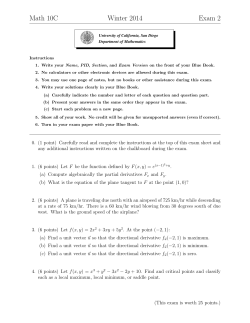
Control allocation Task: (downlowad file admiredata.mat ) The
Control allocation Task: (downlowad file admiredata.mat ) The general structure of the DP system of the vessel is shown in Fig. 1. It consists of a position control and heading control, control allocation system, DP ship model as control object and model environment, and disturbance observer estimated the position and speed vectors value. The DP ship includes actuators thrusters, which include: azimuth thrusters, tunnel, main propulsion and rudder fin. Based on a comparison of a set position and direction values of with estimated values . DP controller determines the required forces and torques compensate deviations from the set values . In this system, the position and direction controller controls independently of the object in three degrees of freedom, and specifying set values generalized vector of longitudinal, transverse forces and moment to the control allocation system. Control allocation system is designed to converte the vector to control signals u - propellers settings. Enviroment Control allocation system =Bu Position and heading controller u Ship DP Measure ments Obserwer Rys.1.Schemat blokowy regulatora DP wraz z układem alokacji pędników. Linear thrust allocation model for DP is described by (1): , (1) where: v - generalized forces and moments vector calculated from controller, u Rm is vector of control signals, BRnxm propeller efficiency matrix depending on: proppeller location relative to geometric center of the ship and the thrust forces coming from the installed propellers. In a linear thrust allocation model is it assumed that the matrix B is constant in each sampling time, and control vector is limited by saturation. The problem of control allocation is to find the vector u satisfying also controls (1) and constraint (2) - (3) at the maximum amplitude and the rate of signals. (2) (3) In digital control systems derivative (t) can be approximated (4) with the sampling time T. (4) Then the scope of changing rate and position of thrusters setting limit to take into account only their position (5) - (6) in the current time t. (5) where (6) The solution of equation (1) with constraint (5) is a standard problem of linear control thrust allocation. If the number of actuators m is greater than the number of controllable degrees of freedom n then the solution of equation (1) doesn't need to be explicitly stated or not at all exist. In contrast, it can be approximated in the constrained optimization (5) and a quadratic objective function J, as shown in Figure 2. control signals Optimisation generalized forces and moment v )T J= u constraints (5) plim rlim Fig. 2. Scheme of control allocation optimization process. Task: Solve the static task of control allocation (1) with constraints (5), using a library of MATLAB Optimization Toolbox. The data for the vector v, the matrix B, the vectors of constraints plim (signal amplitude control) and rlim (speed change control signals) are set in the file admiredata.mat. a) Write your own Matlab code, then compare it to Matlab functions pinv and qr b)Use of property that: Solve linear equation Q (x) = 0 is equivalent to solving a quadratic optimization problem min Q (x) 2 Solve the task using the features quadprog. Analyze and interpret the results. Tips to resolve tasks: If you do not take into account the saturation of actuators is the task of optimizing a quadratic function J has a unique solution in the form of pseudoinvese a matrix: , (10) where B+=Wv-1BT(B Wv-1BT)-1. Pseudoinverse matrix is one of an infinite number of possible solutions to equation (1). One method suggests that for taking Wv matrix coefficients were inverses of the maximum range of variation of of the control (assuming symmetrical constraints). (11) In this way the propellers with large number of making operations are more operated.
© Copyright 2025













